Tree Care Success Guide
Fall is an ideal time of year to plant trees. Planting during the autumn months gives your trees an entire extra growing season to get established before harsh summer weather brings stress. The lower temperatures and increased rain help newly planted trees to establish a strong root system before they go dormant during the winter months.
Find out more about fall tree planting tips and techniques to give your new trees the best possible start to grow healthy and strong below.
Fall Tree Protection
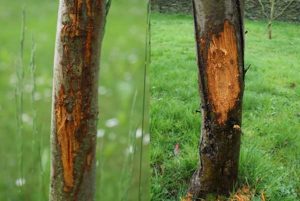
If you notice signs of animal damage, like buck rubs on your trees, you may want to protect them by adding fencing or other protective barriers around your trees. Young trees have thin bark and buck rubs can rob the tree of its protection against the elements and interfere with the vascular system which delivers nutrients.
Watering Tips and Suggestions
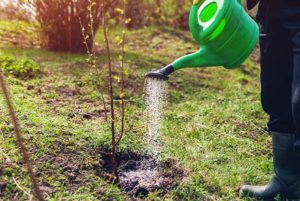
Test the soil around your tree to determine when it needs water. If the soil feels moist, about one to two inches deep, then you don’t need to water. When the soil feels dry, add water slowly to give it time to soak into the ground and reach the tree roots. Try to water in the morning to prevent evaporation and water waste. Your watering schedule will vary depending on the tree type and amount of precipitation your area is getting, but one to two times per week is a good average.
Sick or Stressed Tree Symptoms
There are many signs to watch for that can clue you in when there is a problem with your tree. These include:
- Yellowing leaves
- Wilting
- Brown and dying needs and leaves
- Mold
- Blemishes and spots
- Holes in leaves
- Dead or dropping branches
- Leaning in a tree
If you notice anything usual about the appearance of your tree, you should get it checked out by an expert. These signs can indicate anything from a problem with nutrition, a pest infestation, or a disease. Getting professional help is the best way to make sure you get to the root of the problem to fix the situation and save the tree whenever possible.
Securing a Newly Planted Tree
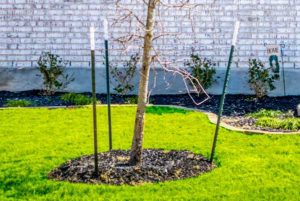
Determine the placement of the twine by rocking the tree gently as you move your hand along the truck. Find the spot where the tree stays upright. This is typically between one-half to two-thirds up from the ground. Tie the tree loosely, so it has room to move and check it often to make sure the twine isn’t rubbing and causing damage.
Whenever you start a project that involves digging, safety should be your main goal. It’s always a good idea to call 811 to determine the placement of underground utility lines before you start to dig. This is also a big time and money saver so you don’t start to plant in the wrong spot and have to start over.
Create a Mulch Ring
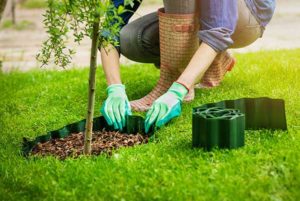
A thick layer of mulch of about three inches is best to help regulate the temperature of the soil, retain moisture, and suppress weed growth. Remember to avoid piling mulch around the base of the tree trunk.
Remove Weeds & Grass
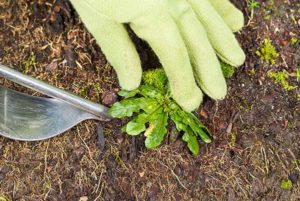
Clear away debris and keep grass trimmed for a healthy tree and neat appearance.
It’s always a good idea to remove weeds by hand to prevent damaging the tree trunk. This is a common cause of tree failure.
Pruning
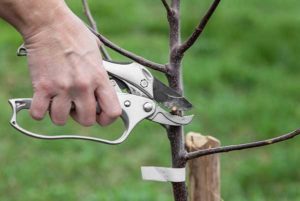
Ideally, you should wait until the second or third year after planting to prune your tree. This gives it a chance to recover from the stress of planting.
Remember to never top your tree. This is where you remove a large portion of the branches or shear off the top. Topping your tree exposes the tree to the elements and leaves it vulnerable to disease, damage, and insects.
Insects & Disease Control
Getting an early start on insect and disease control is crucial and can be the difference from having a beautiful and healthy landscape, or one that is plagued by issues all season long. Focusing on prevention rather than needing to be reactive to tree insects and diseases will save you more time and money in the long run.
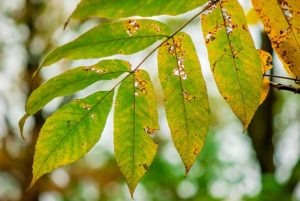
Keeping your trees well-watered, mulched, clear of weeds and debris, and paying attention to planting techniques goes a long way toward prevention of disease and pest problems.
Expert Tree Care
Consider the types of trees that are best for your space. Every plant has a preferred environment when it comes to soil type and moisture level, temperature, space, and sunlight. Choosing a tree that is resistant to local pests and well-suited for the spot you have in mind will aid in your efforts to help it thrive.
You can give your trees the best care possible by getting the advice of an expert. If you have questions about how to plant and care for your trees, notice the beginnings of disease, or even want to give your trees a boost with some extra nutrients, contact Ryan Lawn & Tree. Contact us today for a Free Estimate and let us help you with tree care needs by a RYAN tree care professional!









